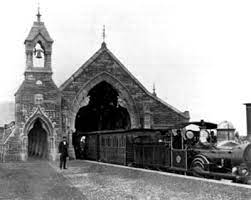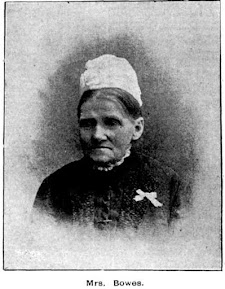Amazing "finds" in the Old Anglican Section
As a member of the Helping Hands gardening group, part of the volunteer group that is the Friends of Rookwood, I often get my hands dirty. Our small group meet regularly and work on various areas of the original part of the Cemetery pulling out weeds, tending to some rose garden areas, clearing areas of dead agapanthus and tidying up (or what I call "resurrecting") some graves from a jungle of overgrowth.
In real estate it's all about location and I'm afraid it's the same in death as well. The areas that are closest to the No. 1 Mortuary Station where the Funeral Train ended its journey in the grounds of the Necropolis is where you will find the grandest monuments and vaults. That relates to all the denominations designated at the time of the design of the Cemetery, Anglican, Catholic, Jewish, Independent, Presbyterian and Wesleyan.
No.1 Mortuary Station located in the Cemetery - Wikipedia
At the moment we are concentrating on liberating some of the monuments in Section 1 of the old Anglican area. After a general cleanup of the "forest" I take photographs and then delve into research of the inhabitants listed.
Over the coming months I will report on some of my finds...one thing in common is that being transported to the Colony as a criminal was no setback for the people that were buried in this area! They took advantage of the opportunities available to them at the time and led far better lives than they could have ever dreamed of in the lands from which they came.
Here is the first installment......
THOMAS BLAKE
I have little early information about Thomas, but I know he was born in Hampshire England in 1805.
In 1824 aged 20 years, he and another young man named Richard Welsh, was sentenced to death for robbing Benjamin Hicks of a silver watch on the Kings Highway at Romsey on the 19th of April, the night of the Fair in that town, and also robbing William Tucker on the same night of four shillings. Sentencing was harsh for highway robbery. His sentence was commuted to transportation for life.
He left England on board the Hercules on Christmas Eve 1824 arriving on these shores on 7th May 1825. By the time of the 1828 census, the first in the Colony, he was listed as a government servant; cook, on the John Macarthur estate in Parramatta.
He married Emma Williams, a free woman who had travelled to Australia with her family, her father being transported for 14 years, under special license in 1832 at St John's Church, Parramatta with the ceremony performed by the Reverend Samuel Marsden.
Thomas eventually became a bread and biscuit maker in Parramatta and accumulated enough wealth to become a Publican. He and Emma had 6 children, the first 3 died within the first few months of their life as did the sixth child. Unfortunately, their only remaining son, Henry Thomas died at the age of 33 and is buried in the family plot.
Their daughter Emma Emmaline however attracted some scandal. It appears that in 1851, aged 14, she went to school as usual and returned home. The only difference was that on this day she was illegally married to a Patrick Meehan. She continued to live at home, but her father was alerted two weeks later and asked the Reverend to explain his actions. It led to the Pastor being summoned at court where he stated that in Liverpool on the 13th of June 1851, he had married the two. He stated that it was not his right to question the young lady about her age (it seems he was desperate for the fee) and he was assured by a "guardian" that Emma Emmaline's father was working in California and had been so for several years and that her mother was dead. Emma Emmaline, when questioned, stated that she freely entered into the marriage with full participation of Meehan, a Catholic, whom she had only known a few months and in the company of friends of his.
The marriage was considered legal but was eventually annulled two years later. Emma Emmaline married again as she is buried in Waverley Cemetery with the surname of Davies dying in 1901 at the age of 64.
Thomas Blake was eventually pardoned in 1861 some 37 years after he was sentenced and died in 1871 of paralysis. His wife Emma died in 1875 and was buried with Thomas soon to be followed by their only son. It seems such a shame that his family died young and that there was a probable estrangement from his only living child.
Thomas Blake monument - find a grave with thanks.
George was born in Greenwich Kent England in 1824 and was one of eight children born to Thomas Pattrick and Jane (nee Nunn). I'm unsure when he arrived on these shores as a free settler, but he was aged 23 when he married Ann Elizabeth Hughes at the Trinity Church, Rushcutters Bay on 23 December 1843. They went on to have 10 children.
George is listed as being declared insolvent in 1851, 1860 in the 1880s and once more in 1893. At each entry he is listed as a "Gentlemen" which meant a man of independent means and that he had interests in racehorses. I was curious to find out how he could be insolvent and a Gentleman at the same time.
A search of his wife's family revealed that her parents were John Terry Hughes and Esther Marsh - who are buried in the nearby Terry monument which had been removed from the Devonshire Street Cemetery when the land was requisitioned for the building of Central Station in 1901. The monument was restored in 2018.
John Terry Hughes immigrated in 1824, was granted 1200 acres by Governor Brisbane, and 800 acres more in 1825. He bought 1000 acres in May of that year and 4000 more in November. He became a brewer, miller, hotelier, whaler, shipowner, merchant and land speculator and was the nephew of Samuel Terry who went from being a convict to the "The Botany Bay Rothschild". Samuel was transported for stealing 400 pairs of stockings, he cut stones for buildings under the direction of the Reverend Samuel Marsden. Soon he became a soldier, an innkeeper, landowner and later a property developer earning unheard of amounts from rental on his properties. Esther Marsh, John Terry Hughes wife, was Samuel Terry's stepdaughter.
George died in May 1898 and Ann joined him some 8 years later.
George Pattrick monument - author's own
It is not hard to speculate that George was financed by his wife's family; no doubt to avoid scandal.
FRANCIS ALBERT BROUGHTON
Francis was the son of Thomas Stafford Broughton and Jane Tindale; one of 15 children (5 died young). Thomas, the son of Captain Thomas Broughton, was apprenticed as a tailor who later had his own business in George Street and then a landowner in the Gundagai Region and Willoughby much closer to Sydney.
In 1842 he was proposed as a candidate for the Macquarie Ward in the first City Council elections. He was elected and selected as an alderman. He was also elected for West Sydney to the first Legislative Assembly on 14 June 1859, but was not re-elected after parliament was dissolved in November 1860. He retired to his property Hazelmere in Glebe where he died in 1901.
Thomas Broughton vault - author's own
Francis was an auctioneer and entered into a partnership with James Robert Lawson, known as Lawson & Broughton but applied for bankruptcy in 1890/91.
In 1883 he married Edith Eleanor Walford in 1883 and they had 4 children.
At the time of his death, he was listed as a retired Bank official. He arrived at his home at "Trebartha" Roslyn Street Darlinghurst at 5.30pm on the 23rd of October 1912 and ran a bath. The gardener saw a bottle being flung from the bathroom and went to investigate; Francis was found unconscious in the bath and died soon after. It would appear he swallowed a bottle of Lysol disinfectant (a favourite suicide vehicle at the time).
Francis Broughton monument - author's own
Edith, his wife, was one of 11 children, to William Barnard Walford and his wife Elizabeth who are buried behind Francis and this is probably why there is no fence separating them. Edith, however, is buried in South Head Cemetery and marked "Our Mother". Her father William was a businessman and landowner, the grandson of a convict who was transported to Hobart in 1791. By the 1840's William was in Sydney and married to Elizabeth Tovey Symonds also of Hobart, the daughter of a convict transported in 1815. After serving his time her father came to Sydney and established a pub called the Waterloo Tavern in Kent Street.
William Barnard Walford delved in real estate and was a director of a number of companies including the Australian Gaslight Company. Their youngest son, Leslie Nichol Walford, Edith's brother, married Dora Alexander. In 1936, as Dora Sheller she helped establish the Black & White Committee of the Royal Blind Society of NSW and served as the Committee’s first president.
William Walford monument - author's own
This area is a real treasure trove of the history of Sydney life and the monuments show the relationship between many of those buried here.
If you have any comments about this blog please do so below or via the group Facebook Page under a search of
rookwoodcemeterydiscoveries
or by simply emailing me at
lorainepunch@gmail.com
The Helping Hands are an enthusiastic and hard-working team. We meet on the second and fourth Saturday of the month and convene at 9.30am in the Village Green car part opposite the All Souls Chapel in Hawthorne Ave.
If you have a few simple tools, like gloves, garden spade and pruning shears come along for a few hours and lend a hand.
Contact me via my email address listed above for more information.
Until next week!









Comments
Post a Comment